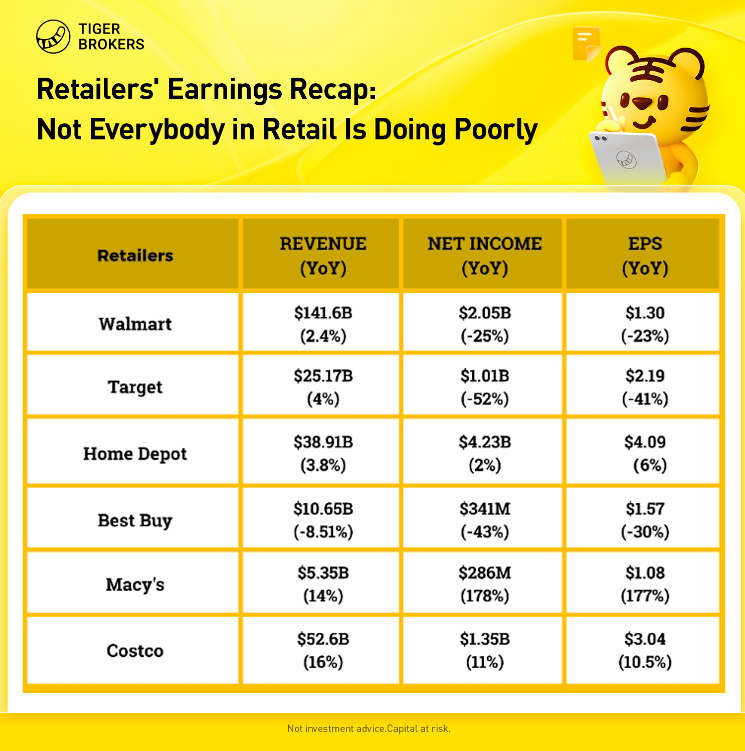Last Week, Walmart and Target posted weaker-than-expected quarterly earnings, and shares of both companies took a hit. Heartening reports from Macy's helped counter a gloomier view that rising costs are eroding profits. It provides a little more confidence that the consumer continues to be reasonably strong.
Strong Consumer Spending Amid Surging Inflation
Target triggered the selloff last Wednesday when it said profits came up short in the first quarter despite positive sales growth. The company failed to anticipate the magnitude of a rapidly shifting macroeconomic backdrop, as well as dramatic changes in customers’ behavior. Target’s stock plummeted nearly 25% for its worst one-day performance since Black Monday in 1987. It also reported operating margins and earnings well below expectations.
Wal-Mart reported disappointing results on last Tuesday and saw its shares plummet the most in 35 years. Despite sales growth, net income dropped by 25% year over year as profits were eroded by higher food and fuel costs, as well as higher wages in addition to more-selective consumers who traded down to less-expensive private-label goods.
Home Depot bucked the trend by posting record sales results and higher-than- expected earnings that were 6% were up from the same period last year, as demand exceeded expectations. While inflation lowered its average ticket price, that was offset by consumers trading up to premium products.
Best Buy reported lower sales for its fiscal first-quarter and the retailer cut its outlook for the year, citing softer demand that doesn’t appear to be letting up. Best Buy’s quarterly net income fell to $341 million, or $1.49 per share, down from $595 million, or $2.32 per share, a year earlier. Excluding items, it earned an adjusted $1.57 per share. Net sales fell to $10.65 billion from $11.64 billion a year earlier.
Macy's revenue grew by 13.6% year over year to $5.3 billion in its fiscal first quarter, which ended on April 30. The gains were fueled by a 12.4% jump in the retailer's comparable-store sales.
"While macroeconomic pressures on consumer spending increased during the quarter, our customers continued to shop," CEO Jeff Gennette said in a press release. "We saw a notable shift back to occasion-based apparel and in-store shopping, as well as continued strength in sales of luxury goods."
Costco beat Wall Street estimates for quarterly revenue and profit on Thursday, boosted by strong consumer spending on its fresh food, home furnishings and fuel offerings amid surging inflation.
However, shares of the warehouse club operator fell about 2% in extended trading as the company's gross margins dropped by 99 basis points in the third quarter.
The weakness in Costco's margins come at a time when U.S. retailers, including Walmart, Target, Kohl's Corp and Best Buy, have warned of decades-high inflation hitting their profits.
What Happened to Retail Earnings
The picture painted by the major retailers “is one of the first real warning signs that consumers are starting to capitulate,” says Tim Murray, capital markets strategist for the multi-asset division at T. Rowe Price.
“Supply is at the root of all of this,” Murray says. “We’ve had numerous unforeseen supply shocks, and it’s hard to see when that ends. Demand may have to fall to the level of supply.”
Consumer spending is a closely watched barometer of economic health in the U.S. because it represents two thirds of gross domestic product. A slowdown in spending is closely aligned with faltering consumer confidence and raises the specter of a potential recession.
“Everybody has to be concerned that we are headed for recession. Earlier selloffs were more about rates rising and growth sold off more than value,'' Murray says. "Now growth is holding up better than value and yields are coming down on the 10-year Treasury, developments consistent with a slowing economy.”
In the past two years, the economy has been roiled by the pandemic, labor shortages, and, more recently, COVID lockdowns and the Russian invasion of Ukraine.
Investors have turned to U.S. Treasuries for safety, despite the Federal Reserve’s intention to fight inflation by raising rates.

Comments